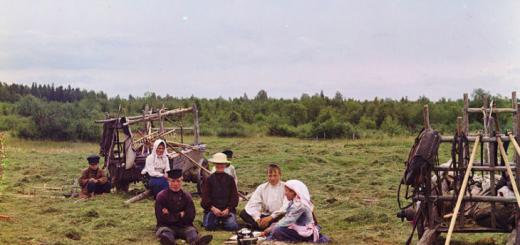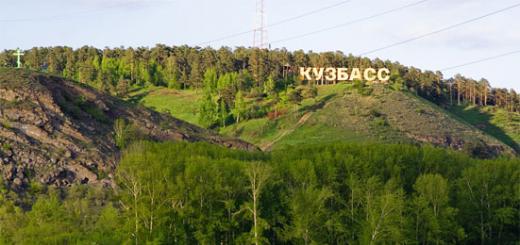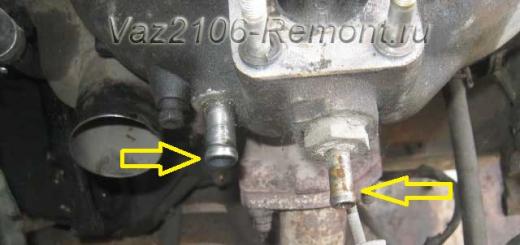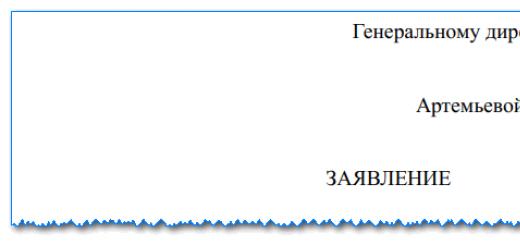Rostekhnadzor directly controls the quality of design work at the construction stage of HIFs. Bogatov Nikolai Dmitrievich, Deputy Head of the Volga-Oka Department of Rostechnadzor, tells about what requirements are imposed on design organizations, what administrative measures are taken against such organizations and enterprises by Rostechnadzor.
What requirements are defined by the legislation for enterprises providing services in the field of HIF design? What legal documents govern their activities?
- According to Part 5 of Art. 48 of the Federal Law of December 29, 2004 No. 190-FZ "Urban Planning Code Russian Federation» persons involved in the preparation of project documentation must have certificates of admission to such types of work issued by a self-regulatory organization. Types of work on the preparation of project documentation that affect the safety of capital construction projects are approved by order of the Ministry of Regional Development of the Russian Federation of December 30, 2009 No. 624. The composition and requirements for the content of sections of project documentation in relation to various types of capital construction objects are established by the Decree of the Government of the Russian Federation of February 16 2008 No. 87 "On the composition of sections of project documentation and requirements for their content."
- What documents must be present in the design documentation for the construction of HIFs?
- The composition of project documentation is also established by Decree of the Government of the Russian Federation dated February 16, 2008 No. 87 "On the composition of sections of project documentation and requirements for their content."
- In the course of construction supervision, among other things, compliance with construction works the OPO project. What are the main violations in this case?
- In the implementation of state construction supervision during the construction of hazardous production facilities in addition to violations of the requirements of industry rules, violations are detected during the performance of general construction works, such as: violation of the anti-corrosion coating of metal structures, identification of areas with cracks in concrete, violation of the fire protection layer of metal structures, the presence of voids at the intersections of premises with communications, non-compliance of welded joints with the established requirements and requirements of the project, and as well as violations of fire, environmental safety in the performance of construction and installation works.
- Are there any cases when there is no design documentation for construction before the start of construction, which has received a positive conclusion from the state expertise? What is the responsibility for this?
- Project documentation for construction, reconstruction, as well as a positive conclusion of the state examination of this project documentation are mandatory for obtaining a building permit in accordance with Part 7 of Art. 51 of the Federal Law of December 29, 2004 No. 190-FZ "Urban Planning Code of the Russian Federation". For the construction, reconstruction of capital construction objects without a building permit, if the construction, reconstruction of capital construction objects provides for obtaining construction permits, administrative liability is provided for in Art. 9.5 of the Code of Administrative Offenses of the Russian Federation, which entails the imposition administrative fine on legal entities in the amount of 500 thousand to 1 million rubles or an administrative suspension of their activities for up to 90 days.
To date, the Volzhsko-Oka Department of Rostekhnadzor has not identified any cases of HIF construction without design documentation that received a positive expert opinion.
The scope of activities of Rostekhnadzor within the framework of state construction supervision also includes supervision of SROs. What violations in the activities of SROs related to the regulation of the activities of design organizations are identified by Rostekhnadzor?
- When the Volga-Oka Department of Rostekhnadzor supervises SROs in the field of architectural and construction design, the main violations are: non-use of disciplinary measures during inspections by self-regulatory organizations of their members, failure to fully comply with the requirements for information openness of the self-regulatory organization website on the Internet.
Are there any cases when the design documentation for the construction of a capital construction facility was developed under the same requirements of regulatory and technical documents, the facility was built or is being built according to newly introduced requirements and is already being commissioned according to third requirements? What measures should the operating entity, the contractor carrying out construction work, other persons take to ensure that the facility complies with the requirements of industrial safety legislation?
- The result of the examination of project documentation is a conclusion on the compliance (positive opinion) or non-compliance (negative opinion) of the project documentation with the requirements of technical regulations and the results of engineering surveys. In the event that the project is found to be inconsistent with the current requirements of the legislation, with the influence of these design decisions on the design and other characteristics of the reliability and safety of capital construction facilities, changes must be made to the project that are subject to re-examination.
What violations are revealed in the course of state construction supervision in the case when design work was carried out by a foreign design organization or when imported equipment was used?
- Regardless of which organization performed engineering surveys and design work, this organization must have certificates of admission to such types of work issued by a self-regulatory organization. In addition, project documentation for the construction of the facility must comply with the requirements of technical regulations in force in Russia. In the course of state construction supervision, violations are also revealed in the performance of work by a construction organization.
What you need to pay attention to in the article:
1. According to Part 5 of Art. 48 of the Federal Law of December 29, 2004 No. 190-FZ "Urban Planning Code of the Russian Federation", persons preparing project documentation must have certificates of admission to such types of work issued by a self-regulatory organization.
2. For the construction, reconstruction of capital construction objects without a building permit, if the construction, reconstruction of capital construction objects provides for obtaining building permits, administrative responsibility is provided for in Art. 9.5 of the Code of Administrative Offenses of the Russian Federation, which entails the imposition of an administrative fine on legal entities in the amount of 500 thousand to 1 million rubles or the administrative suspension of their activities for up to 90 days.
Requirements for the construction of a dangerous production facility
Requirements for the design of a hazardous production facility
When designing hazardous production facilities, quality control of design documentation and architectural supervision of compliance with design decisions during the construction of hazardous production facilities is ensured.
When developing project documentation for the construction, expansion, reconstruction, technical re-equipment, conservation and liquidation of a hazardous production facility (project documentation), the relevant sections of the project documentation at all design stages take into account the requirements and provide for measures to ensure industrial safety, prevention of accidents and localization of their consequences with the necessary justifications and calculations.
When developing these measures, sources of danger, risk factors, conditions for the occurrence of accidents and their scenarios, the number and location of production personnel are taken into account.
For a hazardous production facility ͵ for which federal law"On the Industrial Safety of Hazardous Production Facilities" or Rostekhnadzor of Russia established the obligation to develop an industrial safety declaration, and an industrial safety declaration is developed as part of the project documentation. The declaration of industrial safety is developed, specified and undergoes an industrial safety review in accordance with the regulatory legal acts of Rostekhnadzor of Russia
Design documentation and changes made to it are subject to industrial safety expertise in accordance with the rules for industrial safety expertise established by Rostekhnadzor of Russia.
The conclusion of the industrial safety review submitted to Rostechnadzor of Russia is reviewed and approved in accordance with the procedure established by it.
The decision to start construction, expansion, reconstruction, technical re-equipment, conservation and liquidation of a hazardous production facility (hereinafter referred to as construction) is made if there is a positive conclusion from the industrial safety expertise of the project documentation approved by Rostekhnadzor of Russia.
During the construction process, deviations from the design documentation are not allowed, quality control of construction and installation works is ensured, as well as control of the state of the technical base and technical means of construction and installation.
Upon completion of construction, the hazardous production facility is accepted for operation. During the acceptance of a hazardous production facility for operation, the following is controlled: compliance of the work performed with design solutions to ensure industrial safety; carrying out tests of technical means and equipment that ensure the prevention of accidents and the localization of their consequences, the compliance of tests with the approved program; readiness of personnel and emergency services for actions to localize and eliminate the consequences of accidents.
Requirements for technical devices
Technical devices, incl. foreign-made, must be certified for compliance with industrial safety requirements and regulatory requirements.
In the technical documentation for the technical device, incl. of foreign production, the manufacturer (supplier) indicates the conditions and requirements for safe operation, the methodology for conducting control tests (checks) of this device and its basic components, the service life and service life, the procedure for maintenance, repair and diagnosis.
Various types (types) of technical devices, prior to their use at a hazardous production facility, undergo acceptance tests carried out by the acceptance committee in the prescribed manner.
Based on the results of the acceptance tests and the certificate of compliance with industrial safety requirements, Rostekhnadzor of Russia issues a permit for the use of a specific type (type) of a technical device in the manner prescribed by it
Technical devices are subject to maintenance during the entire period of their use. The volume and timing of preventive maintenance to maintain a technical device in good condition are determined in the technical documentation for this device. The organization operating a hazardous production facility organizes the maintenance of these devices and controls their implementation, as well as ensures the registration of specific types (types) of technical devices with the bodies of Rostekhnadzor of Russia.
When repairing and adjusting technical devices at hazardous production facilities, these works are carried out on the basis of the requirements of the relevant regulations, as well as compliance with the established procedures for planning, quality control and accounting for repair and adjustment work.
Upon reaching the service life specified in the technical documentation, further operation of the technical device is not allowed without carrying out work to extend the safe operation life in the manner prescribed by Rostekhnadzor of Russia
Certification of technical devices
Certificate- This is a document certifying the compliance of the object in question with the requirements of industrial safety.
Certification- this is the process and rules of work, as a result of which a certificate is issued. The rules for certification are established by the federal executive body for standardization, metrology and certification together with Rostekhnadzor of Russia and its territorial bodies.
Certification is carried out by accredited organizations. HIFs use a variety of technical devices subject to certification.
The main classes of technical devices, the permission for the manufacture and use of which is issued by the Federal Mining and Industrial Supervision of Russia (BTP 2/99), are given below.
‣‣‣ Lifting and transport equipment (cranes, hoists (towers), elevators, escalators, passenger conveyors, ropeways and other equipment).
‣‣‣ Boiler equipment, steam and hot water pipelines, equipment operating under pressure over 0.7 kgf/cm2
‣‣‣ Explosion-proof and mining electrical equipment.
‣‣‣ Technical devices for mining and ore-dressing industries and underground facilities not related to mining.
‣‣‣ Equipment and instruments used in blasting for industrial purposes.
‣‣‣ Gas equipment of boilers, process lines and units, gas burners, storage and instantaneous water heaters.
‣‣‣ Technical devices for oil and gas production (oil and gas field, gas processing, drilling equipment; equipment for geological exploration and geophysical works; equipment for main pipeline transport).
‣‣‣ Technical devices used at hazardous production facilities of chemical, petrochemical, oil refining and other industries, working with explosive, toxic, aggressive environments,
‣‣‣ Technical devices for hazardous production facilities for grain storage and processing.
‣‣‣ Equipment for ferrous and non-ferrous metallurgy at hazardous production facilities (blast furnace, coke, steel-smelting, technological for non-ferrous metallurgy; steel-smelting, degassing and steel refining units; continuous casting machines, etc.) ‣‣‣ Electric furnaces, electric furnace installations and devices, where melts of ferrous and non-ferrous metals and alloys based on these melts are obtained ‣‣‣ Equipment for melting cast iron.
‣‣‣ Means of gas-protective respiratory equipment (isolating respirators, air apparatuses, isolating and filtering self-rescuers), gas control devices, technical devices, incl. special protective suits for emergency response.
‣‣‣ Instruments and automation equipment used at hazardous production facilities
‣‣‣ Liquid and vacuum pumps, pump units, air and gas compressors; parts for them.
‣‣‣ Tanks, specialized containers and cylinders for liquefied gases, explosive and toxic environments.
‣‣‣ Pipelines and their components: steel, non-ferrous metals and alloys, non-metallic materials - for hazardous production facilities.
‣‣‣ Electric welding equipment used in hazardous production facilities.
‣‣‣ Fittings for technical devices used at hazardous production facilities.
During operation, technical devices are subject to industrial safety expertise.
Requirements for the construction of a hazardous production facility - concept and types. Classification and features of the category "Requirements for the construction of a hazardous production facility" 2017, 2018.
"... Construction - the creation of buildings, structures, structures (including on the site of demolished capital construction projects) ..."
“... Reconstruction is a change in the parameters of a capital construction object, its parts (height, number of floors, area, volume), including a superstructure, restructuring, expansion of a capital construction object, as well as replacement and (or) restoration of load-bearing building structures of a capital construction object, except for the replacement of individual elements of such structures with similar or other elements that improve the performance of such structures and (or) the restoration of these elements ... " - Urban Planning Code of the Russian Federation of December 29, 2004 N 190-FZ.
Specifics of the design of hazardous production facilities (HPO)
There are several fundamental differences between the design of HIFs and civil facilities:
- The development of design documentation for hazardous production facilities (of all classes) requires increased attention from the designer to production safety organizations(industrial, fire, labor organization, etc.). The requirements of the regulatory framework for these objects have also been tightened.
- Often, when designing HIFs, it is required development of specific special sections provided for by federal laws- "Engineering and technical measures for civil defense and prevention of natural and man-made emergencies" (PM GOChS), "Structured system for monitoring and managing engineering systems of buildings and structures (SMIS)", "Declaration of industrial safety HIF (DPB)".
- When designing HIFs in the oil, gas, chemical industry, as well as in other industries one way or another connected with technological systems and installations, The Technology Group plays a key role in the design(subsection "Technological solutions").
Reconstruction of hazardous production facilities (HPO)
The most common task of the existing HPF is the need for reconstruction in connection with the expansion of the type of activity and the increase in capacity.
When developing a reconstruction project, the main difficulty is the limited area for future development and compliance with all existing standards for the placement of additional buildings and equipment. Also, when expanding the existing HPF, it is necessary to take into account the existing technology and compatibility with the proposed solutions, storage and delivery locations for raw materials and finished products. Particular attention at the initial stage should be given to the need pre-project survey and collection of initial data for design.
The study, analysis of existing design documentation and the relevance of the adopted design decisions is also one of the main tasks in the reconstruction. Very often there is a need to develop new sections for the entire GRO, despite the positive conclusion of the latest examination, in accordance with changes in legislation. When developing special sections, it is important to organize a coordinated and coordinated work of all performers, taking into account each design decision made.
Design of a new hazardous production facility (HPO)
When designing new hazardous production facilities (highly hazardous, HIFs), special attention is paid to facilities adjacent to the territory allotted for construction, the presence of existing sanitary and environmental protection zones, residential development zones, and the approval procedure for allotment of a land plot. The development of all sections of the project documentation is carried out from scratch, therefore, in order to avoid mistakes made during the design, it is important to cooperate with one design organization within the framework of one project, as well as correctly state the requirements and wishes of the customer in the terms of reference.
Design deadlines
It is important to understand that the timing of the design work depends on the availability of initial data, as well as on the depth of study of the terms of reference and the Customer's requirements for the object. Often in practice, the Customer changes his requirements already in the design process due to the lack of elaboration at the stage of preparing the TOR, because of this, the deadlines can be shifted, and the designers have to do “double” work. Minimizing this moment will allow carrying out pre-project work, during which the main technical solutions will already be developed and agreed with the Customer, after which they will be reflected in the project. This aspect is especially important when it comes to a large production facility.
Thanks to their rich experience, our specialists are able to complete design work within the allotted time without unnecessary headaches for the Customer, and are also able to solve the most non-standard tasks. And by contacting us at the stage of preparation for design work You can always get competent advice from experienced professionals.
Olga Ivanovna Ryabova, State Inspector of the Department of General Industrial and State Construction Supervision of the Volga-Oka Department of Rostekhnadzor, tells about the specific requirements defined by the legislation for the construction and reconstruction of HIFs.
What requirements are defined by the legislation for enterprises and organizations providing services in the field of HIF construction? What legal documents govern their activities?
- Construction, reconstruction of capital construction facilities, as well as their overhaul is regulated by Federal Law No. 190-FZ of December 29, 2004 "Urban Planning Code of the Russian Federation" (hereinafter referred to as the Urban Planning Code), other federal laws and other regulatory legal acts adopted in accordance with them Russian Federation. According to part 2 of Art. 52 of the Town Planning Code, work on the construction, reconstruction, overhaul of capital construction facilities that affect the safety of capital construction facilities should be carried out only individual entrepreneurs or legal entities who have certificates of admission to such types of work issued by a self-regulatory organization. Types of construction, reconstruction, overhaul works that affect the safety of capital construction facilities are approved by Order of the Ministry of Regional Development of the Russian Federation dated December 30, 2009 No. 624.
- What regulatory and technical documents determine the order of construction works of HIFs?
- Construction is carried out in accordance with the task of the developer or technical customer, project documentation, the requirements of the town-planning plan of the land plot, the requirements of technical regulations, and at the same time, safety of work for third parties and the environment, compliance with labor safety requirements, safety of cultural heritage sites must be ensured. The safety of buildings and structures, as well as the construction process associated with buildings and structures, is ensured by complying with the requirements of the Federal Law of December 30, 2009 No. 384-FZ "Technical Regulations on the Safety of Buildings and Structures" and the requirements of standards and sets of rules included in the lists, approved by the Decree of the Government of the Russian Federation of December 26, 2014 No. 1521 and the Order of Rosstandart of March 30, 2015 No. 365, or the requirements of special technical conditions.
What violations are detected by inspectors of the Volga-Oka Department of Rostekhnadzor when inspecting construction sites of HIFs?
- When exercising state construction supervision during the construction of hazardous production facilities, inspectors of the Volga-Oka Department of Rostekhnadzor first of all identify violations of the established construction procedure, liability for which is provided for in Art. 9.5 of the Code of Administrative Offenses of the Russian Federation, namely:
1. Construction, reconstruction of capital construction projects without a building permit.
2. Violation of the deadlines for sending a notice of the start of construction, reconstruction of capital construction projects or failure to notify of the deadlines for completion of works that are subject to verification.
3. Continuation of work until the drawing up of acts on the elimination of deficiencies identified by Rostekhnadzor during construction and reconstruction.
4. Operation of a capital construction facility without permission to put it into operation.
Also, when carrying out control measures, organizations are identified that perform work that affects the safety of capital construction objects, without a certificate of admission to these types of work issued for especially dangerous objects.
At construction sites, defects are identified in the main types of construction and installation works, violations of the requirements of design documentation, the procedure for maintaining executive documentation, the requirements of industry rules, as well as violations of fire and environmental safety during construction and installation works.
What you need to pay attention to in the article:
The safety of buildings and structures, as well as the construction process associated with buildings and structures, is ensured by complying with the requirements of the Federal Law of December 30, 2009 No. 384-FZ "Technical Regulations on the Safety of Buildings and Structures" and the requirements of the standards and sets of rules included in the lists, approved by the Decree of the Government of the Russian Federation of December 26, 2014 No. 1521 and the Order of Rosstandart of March 30, 2015 No. 365, or the requirements of special technical conditions.
1. Technical re-equipment, overhaul, conservation and liquidation of a hazardous production facility are carried out on the basis of documentation developed in accordance with the procedure established by this Federal Law, taking into account the legislation on urban planning. If the technical re-equipment of a hazardous production facility is carried out simultaneously with its reconstruction, the documentation for the technical re-equipment of such a facility is included in the relevant project documentation. Documentation for the conservation and liquidation of a hazardous production facility is subject to industrial safety expertise. Documentation for the technical re-equipment of a hazardous production facility is subject to industrial safety expertise if the specified documentation is not included in the design documentation of such a facility, subject to expertise in accordance with the legislation of the Russian Federation on urban planning. Technical re-equipment, conservation and liquidation of a hazardous production facility are not allowed without a positive conclusion of the industrial safety review, which is duly entered in the register of conclusions of the industrial safety review, or if the documentation for the technical re-equipment of a hazardous production facility is part of the design documentation of such an object, without a positive the conclusion of the examination of the design documentation of such an object.
(see text in previous edition)
2. Deviations from the design documentation of a hazardous production facility in the process of its construction, reconstruction, overhaul, as well as from the documentation for technical re-equipment, overhaul, conservation and liquidation of a hazardous production facility in the process of its technical re-equipment, conservation and liquidation are not allowed. Changes made to the design documentation for the construction, reconstruction of a hazardous production facility are subject to an examination of the design documentation in accordance with the legislation of the Russian Federation on urban planning. Changes made to the documentation for the conservation and liquidation of a hazardous production facility are subject to industrial safety expertise. Changes made to the documentation for the technical re-equipment of a hazardous production facility are subject to industrial safety expertise and are agreed with the federal executive body in the field of industrial safety or its territorial body, except for the case if the specified documentation is part of the design documentation subject to expertise in accordance with legislation of the Russian Federation on urban development.
(see text in previous edition)
3. In the process of construction, reconstruction, overhaul, technical re-equipment, conservation and liquidation of a hazardous production facility, organizations that have developed the relevant documentation shall exercise architectural supervision in the prescribed manner.
(see text in previous edition)
3.1. Compliance of the constructed, reconstructed hazardous production facilities with the requirements of technical regulations and design documentation is established by the conclusion of the federal executive body authorized to carry out state construction supervision or the executive body of the constituent entity of the Russian Federation authorized to carry out state construction supervision in accordance with the legislation of the Russian Federation on urban planning activities.
(see text in previous edition)










